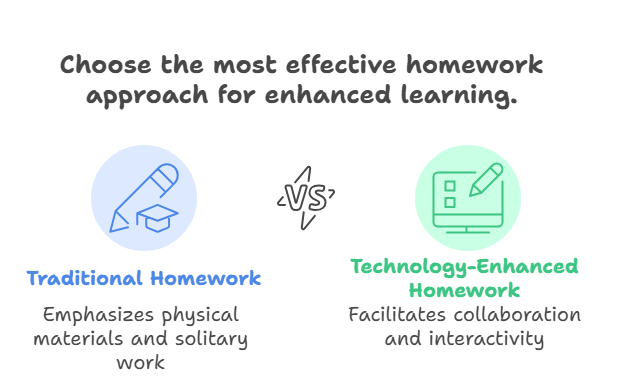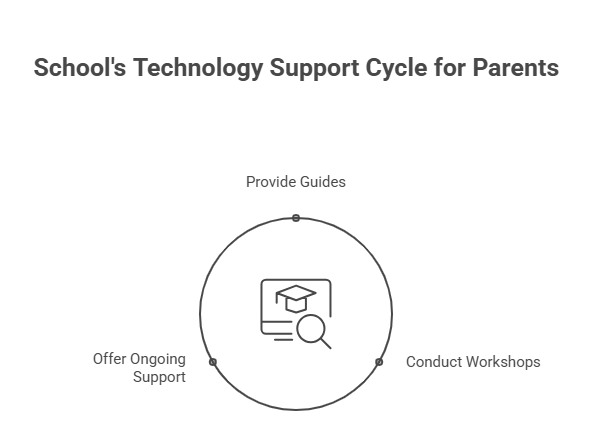Transforming homework with technology: why parents must adapt
Every parent knows the evening struggle: homework battles, endless worksheets and the constant tug-of-war between school assignments and family time. But in today’s digital-first world, those late-night frustrations don’t have to look the same. Technology has not only reshaped classrooms but also the way children learn and complete assignments at home.
Transforming homework with technology is not about replacing parental guidance, it’s about empowering families to work smarter, not harder. With the right digital tools, homework shifts from a stressful task to an engaging, community-supported experience. And at the heart of this transformation is parent engagement, where schools, families and students collaborate seamlessly through technology.

Why parents struggle with homework in the digital age
Despite new tools, many parents feel more pressure than ever when it comes to homework.
Why?
- Time constraints: Working parents often rush between jobs, chores and schoolwork. Homework becomes a late-night marathon instead of a meaningful activity.
- Digital distractions: Social media, games and endless notifications compete for a child’s attention. Parents struggle to manage healthy screen habits.
- Tech anxiety: For many parents, especially those not raised in the digital age, homework with apps, online portals and AI tools can feel overwhelming.
- Lack of visibility: In traditional systems, parents only learn about homework progress when report cards arrive. This creates disconnect and frustration.
This is where homework tips for parents must evolve: success isn’t just about discipline or routines anymore. It’s about learning how to cope with technological changes and turning those challenges into opportunities for deeper engagement.
Transforming homework with technology: from worksheets to AI tutors
In the past, homework was largely about repetition: memorizing multiplication tables, rewriting essays, or solving problem sets. Today, transforming homework with technology opens doors to a very different experience.

- Interactive learning platforms
Instead of paper worksheets, students now use apps and portals with instant feedback. This helps children correct mistakes in real time and builds confidence.
- AI-powered homework help for parents and students
From math-solving bots to language-learning assistants, AI tools provide personalised support at scale. Parents no longer need to be experts in every subject, technology helps fill the gaps.
- Gamified homework with technology
Digital platforms use points, badges and progress dashboards to keep students motivated. Homework becomes less of a “chore” and more of a challenge.
- Real-time parent-teacher communication
Modern platforms allow parents to see assignments, track completion and even communicate directly with teachers. This transparency strengthens the school-home connection.
- Collaboration homework projects in the digital world
Homework with technology enables group projects where students can co-create in shared online spaces, preparing them for real-world teamwork.
The shift is clear: technology isn’t just making homework faster, it’s making it smarter, more engaging and more connected to both parents and schools.
The parent engagement angle: building a connected school community
Homework is no longer just a private matter between student and teacher. With digital platforms, parents are becoming true partners in the learning process. This shift has transformed the role of homework from a solitary task into a collaborative journey that connects families and schools.
Why parent-teacher partnerships matter
Research consistently shows that students perform better when parents are actively engaged in their education. When parents have access to real-time updates, they can step in earlier, offer engagement, or seek extra help before small gaps become big struggles.
How technology builds transparency
- Dashboards and portals: Parents can see assignments, due dates and progress without waiting for teachers updates.
- Notifications and alerts: Automated reminders help parents stay on top of their child’s responsibilities.
- Communication channels: Direct messaging and shared platforms eliminate the “lost homework” mystery.
Community-driven learning
When multiple parents are engaged through a school’s digital ecosystem, the sense of community strengthens. Parents can exchange homework tips, share success strategies and even co-support each other’s children during projects.
Case insight: Platforms like iScuela integrate school operations with AI-driven learning tools and parental engagement features. By reducing administrative friction, they allow parents to focus on supporting their children instead of navigating complex systems.
This connected ecosystem ensures that homework with technology isn’t just about efficiency, it’s about building trust and a collaborative school community.
Practical homework tips for parents using technology
Parents often ask: “ How do I make the most of these tools without letting screens take over?” Here are actionable strategies for balancing digital learning with real-world parenting:
Create a distraction-free homework zone
Set up a dedicated space with minimal noise and distractions. Encourage children to treat it as their “digital study hub.
Set boundaries on screen time
Not all screen time is equal. Use parental controls or apps to limit entertainment while allowing access to educational platforms.
Leverage collaborative tools
Encourage your child to use shared documents, digital whiteboards or group chat features to connect with peers on homework projects.
Encourage self-paced learning
AI-powered tools allow students to learn at their own pace. Remind them it’s okay to revisit lessons or practice multiple times.
Stay updated through school platforms
Regularly check progress dashboards and school notifications. Use these insights to spark conversations with your child about their learning journey.
When parents actively use these strategies, homework with technology becomes less of a battle and more of an opportunity for bonding, growth and empowerment.

Helping parents cope with technological changes
For many parents, the rapid rise of digital tools can feel intimidating. The key is not to resist these changes but to approach them with curiosity and patience.
Simplifying the transition
- Onboarding guides & tutorials: Schools can provide simple walkthroughs and videos for parents.
- School-led tech workshops: Group sessions help parents ask questions and learn together.
- Dedicated support teams: Having a single point of contact, like iScuela’s white-glove service, reduces stress and ensures parents never feel “lost.”
The role of empathetic school leadership
Strong leadership in schools makes a big difference. When school leaders prioritise parent engagement and provide accessible tools, families feel supported instead of overwhelmed.
Building confidence in parents
When parents see that technology genuinely helps their children improve grades, reduce stress and save time, their confidence in digital learning grows.
Platforms that manage operations end-to-end, like iScuela, remove fragmentation and confusion. Instead of juggling multiple apps and passwords, parents can focus on what truly matters: supporting their child’s success.

The future of homework: A shared journey between parents, students and schools
Homework has always been a bridge between school and home. But in the digital age, that bridge is becoming stronger, more transparent and more collaborative than ever before.
The future of transforming homework with technology lies in creating a seamless ecosystem where parents, teachers and students work as one team.
From Monitoring → Mentoring → Motivating
- Monitoring: Parents gain visibility into assignments and progress through digital dashboards.
- Mentoring: With insights in hand, parents can offer timely help, encouragement or resources.
- Motivating: When technology reduces friction, parents can focus on inspiring their children instead of managing logistics.
Hybrid learning becomes the “New Homework”
Tomorrow’s homework will be less about worksheets and more about interactive projects, multimedia storytelling, coding and collaboration across time zones. Parents won’t just “check work,” they’ll help children explore ideas, solve real challenges and build digital literacy.
Vision of stress-free, tech-supported homes
Imagine this: A child logs in, completes assignments with AI-powered guidance, parents receive instant progress updates and teachers see consolidated results. Instead of late-night battles, families enjoy calm evenings knowing learning is under control.
This vision isn’t far away with platforms like iScuela, it’s already becoming a reality. By removing fragmented tools and delivering one unified experience, schools can empower parents to embrace this transformation confidently.

Conclusion
When homework becomes an opportunity
Technology is not replacing parents in the learning journey it’s empowering them. By shifting from endless paper tasks to smart, interactive and community-driven systems, families can finally reclaim the time, energy and joy that homework often taken away.
- Parents cope with technological changes more smoothly when schools provide guidance and user-friendly platforms.
- Homework tips for parents now include digital strategies, not just discipline or schedules.
- Homework with technology builds bridges between families and schools, ensuring every child feels supported.
At iScuela, we believe that when schools and parents unite through technology, homework transforms into opportunity. Our unified school operating system is designed to simplify complexity, strengthen parent engagement and reimagine how families support learning at home.
The future of homework isn’t just digital it’s human, connected and stress-free. And with visionary solutions leading the way, it’s a future where every parent can feel confident, every teacher supported and every child empowered to succeed.




